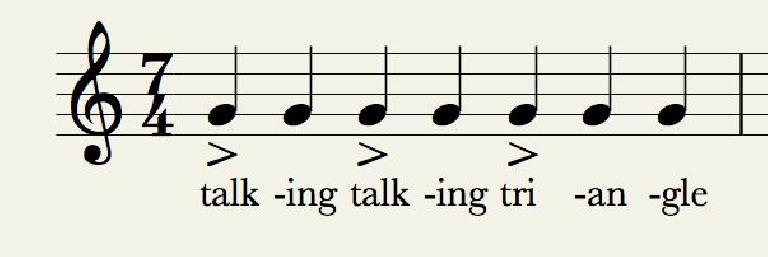때마다 당신은 4/4, 음악 작곡에 사용되는 가장 일반적인 박자에 상관없이 DAW, 박자 디폴트의 새로운 세션을로드 할 수 있습니다. 빠른 검토를 필요로하는 사람들을 위해, 박자의 상단 노트는 측정 당 비트 수를 의미하고 아래 수는 노트의 종류가 이렇게 서명에있는 모든 음의 시간 값을 결정하는 하나의 비트를 수신에 대해 설명합니다.
대부분의 생산자는, 특히 EDM의 다양한 자연적으로 안내된다
Common Odd Meters
5/4 및 7/4
의심의 여지없이, 5/4 및 7/4은 가장 일반적으로 사용되는 홀수 박자입니다. 분 음표는 여전히 모두에서 하나의 비트를 수신하지만, 각각의 고유 한 느낌이있다. 모두가 어느 비트가 멜로디 문구 또는 홈에 강조에 관해서 특히, 엄격하게 이배 또는 삼중으로 생각하는 우리의 자연적인 경향에 대해 이동합니다. 어떠한 박자에서, 제 2 차 또는 비트가 약한 강조 박동 뒤에 가장 강조를 수신한다.
5/4에서 기억에 남는 음악 테마 중 하나는 미션 임파서블 테마입니다. 많은 사람들은 폴 데스몬드를 인식
7/4는 모든 장르에 걸쳐 5/4만큼 일반적인 것이 아니라 피터 가브리엘 "Solsbury 힐"핑크 플로이드의 주요 리프 등 일부 주목할만한 사례가 있습니다
나는 최근에 문구를 사용하는 프레임 드럼 예술가와 교육자와 협력
당신은 또한 시도 할 수 있습니다 :
- (123) (12) (12)
- (123) 1234
비트 강조에
5/8, 7/8 등
5/8 및 5/4 및 7/4와 비슷한 방식으로 7/8 일, 음의 시간 값에서 시프트되는 주요 차이점. 5/8 시간에서 8 번째 노트는 1 박, 분 음표 2 박자 등을 받는다. 위의 설명 같은 그룹은 여전히 적용됩니다. 이 시간 서명은 종종 다른 화합물 미터와 혼합된다. 물건을 변경하거나 다른 문구를 종료가 예를 들어, 작곡가는 6/8 또는 9/8 주위 조성물을 중심으로 수 있지만, 여기에 이상한 측정에 던지거나. 라디오 헤드는 자신의 작품에 많은 이상한 시간과 교류 서명을 사용하고있다. 7/8은 부분적으로 사용된다 "편집증 안드로이드."
Compound Meter
복합 시간 또는 복합 측정기는 3 등분으로 나누어 비트가 포함되어 있습니다. 복합 미터는 종종 가장 일반적인 3/8, 6/8, 9/8, 12/8 인 트리플 미터라고합니다. 오케스트라 음악, 도체가 느린 조성물에 각 비트의 펄스를 제공 빠른 사람에서, 첫 번째 동안 각 비트 그룹의 펄스가 강조된다. 즉, 빠른 3/8 조각, 도체 측정 당 하나의 박자, 6/8의 2 박자, 9/8에 3 비트와 12/8의 측정에 4 비트를 표시합니다. 이 때 템포 변경 수행 패턴을 방해 할 것입니다하지만 이론적으로, 화합물 시간도, 세 쌍둥이와 간단한 미터 (4/4 또는 3/4)로 설명 될 수있다. 에 관계없이, 화합물 미터 간단한 미터 그냥 돈있는 스윙을
유명한 조각과 복합 측정기의 스타일은 바로크 춤 아일랜드 지그 및 자주 6/8에 많은 문화에서 다른 민속 무용을 포함한다. "F
Listen, Listen, Listen
이러한 리듬의 작동 방식을 이해하는 가장 좋은 방법은 이러한 시간 서명 작성 유명한 조성물에 들어하는 것입니다. 박수와 멜로디, 리듬과 조화가 얽혀 방법에 대한 느낌을 얻을 수에 따라 계산합니다. 당신이 아직은 홀수 박자 또는 화합물 계 조성에 뛰어 어려우면, 다른 리듬 접근 방식을 사용하여 클래식과 대중 음악을 많이 들어요. 당신의 연구는 현재와 미래의 일에 대한 영감이 될 것입니다. 찾아 가기!






 © 2024 Ask.Audio
A NonLinear Educating Company
© 2024 Ask.Audio
A NonLinear Educating Company
Discussion
Another way of thinking of compound meters - well, roughly half of them - is to realize that any meter where the "numerator", or beats in the measure is a higher number than the pulse, or "denominator", those meters' pulse can be counted equally with the foot or in the head. So 7/4, as in "Money", you can simply tap out 7 quarter notes and then start over at 1 and continue tapping out equal beats beyond. It's an easy way to approach an often misunderstood part of learning rhythm. Shorter meters like 7/8, 5/8 or 7/16, those take more time to understand and teach, obviously!
Want to join the discussion?
Create an account or login to get started!